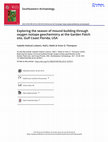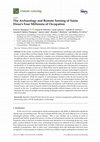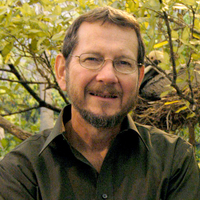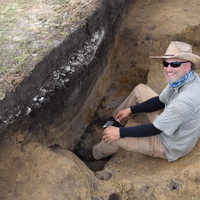Papers by Isabelle Holland-Lulewicz

PLoS One, 2023
Zooarchaeological datasets are often large, complex, and difficult to visualize and communicate. ... more Zooarchaeological datasets are often large, complex, and difficult to visualize and communicate. Many visual aids and summaries often limit the patterns that can be identified and mask interpretations of relationships between contexts, species, and environmental information. The most commonly used of these often include bar charts, pie charts, and other such graphs that aid in categorizing data and highlighting the differences or similarities between categories. While such simplification is often necessary for effective communication, it can also obscure the full range of complexity of zooarchaeological datasets and the human-environment dynamics they reflect. In this paper, we demonstrate the utility of formal network graphs to capturing the complexity of zooarchaeological datasets and to effectively highlighting the kinds of relationships between contexts, time, and faunal assemblages in which zooarchaeologists are primarily interested. Using a case study from southwestern Florida (USA), we argue that network graphs provide a quick solution to visualizing the structure of zooarchaeological datasets and serve as a useful aid in interpreting patterns that represent fundamental reflections of human-centered ecosystems.
The Journal of Island and Coastal Archaeology, Dec 2, 2021
The 81st Annual Meeting of the Society for American Archaeology, 2017

Southeastern Archaeology, Oct 20, 2019
The American Southeast saw the development of large ceremonial village centers, the coalescence o... more The American Southeast saw the development of large ceremonial village centers, the coalescence of households, and monumental architecture integrated into village layout during the Middle Woodland period (ca. AD 1-600). These shifts toward more sedentary lifeways occurred independently of, and prior to, the domestication of plants across the Southeast. This paper examines the seasonality of monumental construction at the Garden Patch site located on the central Gulf Coast of Florida. This site contains evidence for rapid mound construction that followed a predetermined site plan. Here, we present oxygen isotope analyses of archaeological mollusk shells (Crassostrea virginica) to evaluate the seasonality and periodicity of monument construction. We conclude that mound construction occurred during the cooler months of the year. Ultimately, this contributes to an anthropological understanding of the development of these early ceremonial centers in the Southeast.
The 81st Annual Meeting of the Society for American Archaeology, 2016
University Press of Florida eBooks, Apr 18, 2023
The 84th Annual Meeting of the Society for American Archaeology, 2019

PLOS ONE
Circular shell rings along the South Atlantic Coast of North America are the remnants of some of ... more Circular shell rings along the South Atlantic Coast of North America are the remnants of some of the earliest villages that emerged during the Late Archaic (5000–3000 BP). Many of these villages, however, were abandoned during the Terminal Late Archaic (ca 3800–3000 BP). We combine Bayesian chronological modeling with mollusk shell geochemistry and oyster paleobiology to understand the nature and timing of environmental change associated with the emergence and abandonment of circular shell ring villages on Sapelo Island, Georgia. Our Bayesian models indicate that Native Americans occupied the three Sapelo shell rings at varying times with some generational overlap. By the end of the complex’s occupation, only Ring III was occupied before abandonment ca. 3845 BP. Ring III also consists of statistically smaller oysters harvested from less saline estuaries compared to earlier occupations. Integrating shell biochemical and paleobiological data with recent tree ring analyses shows a clea...
Science Advances
The eastern oyster (Crassostrea virginica) is an important proxy for examining historical traject... more The eastern oyster (Crassostrea virginica) is an important proxy for examining historical trajectories of coastal ecosystems. Measurement of ~40,000 oyster shells from archaeological sites along the Atlantic Coast of the United States provides a long-term record of oyster abundance and size. The data demonstrate increases in oyster size across time and a nonrandom pattern in their distributions across sites. We attribute this variation to processes related to Native American fishing rights and environmental variability. Mean oyster length is correlated with total oyster bed length within foraging radii (5 and 10 km) as mapped in 1889 and 1890. These data demonstrate the stability of oyster reefs despite different population densities and environmental shifts and have implications for oyster reef restoration in an age of global climate change.
Geological Society of America Abstracts with Programs

Southeastern Archaeology
ABSTRACT The American Southeast saw the development of large ceremonial village centers, the coal... more ABSTRACT The American Southeast saw the development of large ceremonial village centers, the coalescence of households, and monumental architecture integrated into village layout during the Middle Woodland period (ca. AD 1–600). These shifts toward more sedentary lifeways occurred independently of, and prior to, the domestication of plants across the Southeast. This paper examines the seasonality of monumental construction at the Garden Patch site located on the central Gulf Coast of Florida. This site contains evidence for rapid mound construction that followed a predetermined site plan. Here, we present oxygen isotope analyses of archaeological mollusk shells (Crassostrea virginica) to evaluate the seasonality and periodicity of monument construction. We conclude that mound construction occurred during the cooler months of the year. Ultimately, this contributes to an anthropological understanding of the development of these early ceremonial centers in the Southeast.

The Journal of Island and Coastal Archaeology
ABSTRACT Research at Crystal River and Roberts Island Shell Mound Complex, on the western coast o... more ABSTRACT Research at Crystal River and Roberts Island Shell Mound Complex, on the western coast of Florida, USA, offers a quantitative assessment of the temporality of shell deposit construction, Native subsistence practices, and mobility patterns through stable oxygen isotope data from eastern oyster (C. virginica). The δ18Owater values of oysters vary synchronously with salinity, assuming relatively constant δ18Owater/salinity gradients since the time of occupation, allowing for an examination of shifts in oyster habitat exploitation over time. Our previous (Thompson et al. 2015) study indicated that midden accumulation occurred throughout the year, while oysters from mound deposits were collected in colder months. New data indicate that in addition to differential season of collection, habitat exploitation also varied. During early occupation at the site, oysters were collected primarily from lower saline habitats, while in later phases oysters were obtained from higher salinity waters; we relate this to a lower sea level and concomitant settlement shift seaward. Additionally, oyster from later mound contexts was collected from higher saline habitats relative to those in midden contexts; Native people may have targeted specific bioherms at certain times for the year for feasting-related mound construction.

Radiocarbon
In coastal and island archaeology, carbonate mollusk shells are often among the most abundant mat... more In coastal and island archaeology, carbonate mollusk shells are often among the most abundant materials available for radiocarbon (14C) dating. The marsh periwinkle (Littorina irrorata) is one of these such species, ubiquitously found along the Atlantic and Gulf coasts of the United States in both modern and archaeological contexts. This paper presents a novel approach to dating estuarine mollusks where rather than attempting to characterize the size and variability of reservoir effects to “correct” shell carbonate dates, we describe a compound-specific approach that isolates conchiolin, the organic matter bound with the shell matrix of the L. irrorata. Conchiolin typically constitutes <5% of shell weight. In L. irrorata, it is derived from the snail’s terrestrial diet and is thus not strongly influenced by marine, hardwater, or other carbon reservoir effects. We compare the carbon isotopes (δ13C and Δ14C) of L. irrorata shell carbonate, conchiolin, and bulk soft tissue from six ...

Remote Sensing
In this study, we present the results of a comprehensive, landscape-scale remote sensing project ... more In this study, we present the results of a comprehensive, landscape-scale remote sensing project at Santa Elena on Parris Island, South Carolina. Substantial occupation at the site extends for over 4000 years and has resulted in a complex array of features dating to different time periods. In addition, there is a 40-year history of archaeological research at the site that includes a large-scale systematic shovel test survey, large block excavations, and scattered test units. Also, modern use of the site included significant alterations to the subsurface deposits. Our goals for this present work are threefold: (1) to explicitly present a logical approach to examine sites with long-term occupations; (2) to examine changes in land use at Santa Elena and its implications for human occupation of this persistent place; and (3) to use the remote sensing program and past archaeological research to make substantive suggestions regarding future research, conservation, and management of the site. Our research provides important insight into the distribution of cultural features at this National Historic Landmark. While the majority of archaeological research at the site has focused on the Spanish period, our work suggests a complex and vast array of archaeological features that can provide insight into over 4000 years of history in the region. At a gross level, we have identified possible Late Archaic structures, Woodland houses and features, Late Prehistoric and early Historic council houses, and a suite of features related to the Spanish occupation which builds on our previous research at the site. In addition to documenting possible cultural features at the site, our work illustrates the value of multiple remote sensing techniques used in conjunction with close-interval shovel test data.

American Antiquity
Over the past 30 years, the number of US doctoral anthropology graduates has increased by about 7... more Over the past 30 years, the number of US doctoral anthropology graduates has increased by about 70%, but there has not been a corresponding increase in the availability of new faculty positions. Consequently, doctoral degree-holding archaeologists face more competition than ever before when applying for faculty positions. Here we examine where US and Canadian anthropological archaeology faculty originate and where they ultimately end up teaching. Using data derived from the 2014–2015 AnthroGuide, we rank doctoral programs whose graduates in archaeology have been most successful in the academic job market; identify long-term and ongoing trends in doctoral programs; and discuss gender division in academic archaeology in the US and Canada. We conclude that success in obtaining a faculty position upon graduation is predicated in large part on where one attends graduate school.
Journal of Archaeological Science: Reports
Abstract We examined the shell size of 3262 eastern oysters ( Crassostrea virginica ) to assess d... more Abstract We examined the shell size of 3262 eastern oysters ( Crassostrea virginica ) to assess diachronic patterns in shellfish exploitation on Ossabaw Island, Georgia. These measurements taken on shell size and morphology were compared between a Late Archaic shell ring, a Late Woodland shell-filled pit, and a Late Mississippian midden-mound to evaluate changes in oyster population ecology, as it related to large scale changing environmental conditions and Native America subsistence practices over time. Our results indicate stability in oyster populations during the Late Archaic with a following decrease in oyster size through the Late Woodland into the Late Mississippian. We attribute this decrease to combination to human predation and large-scale climate fluctuations, with the latter being the primary driver of this shift in size.

PloS one, 2018
Between 1985 and 2014, the number of US doctoral graduates in Anthropology increased from about 3... more Between 1985 and 2014, the number of US doctoral graduates in Anthropology increased from about 350 to 530 graduates per year. This rise in doctorates entering the work force along with an overall decrease in the numbers of tenure-track academic positions has resulted in highly competitive academic job market. We estimate that approximately79% of US anthropology doctorates do not obtain tenure-track positions at BA/BS, MA/MS, and PhD institutions in the US. Here, we examine where US anthropology faculty obtained their degrees and where they ultimately end up teaching as tenure-track faculty. Using data derived from the 2014-2015 AnthroGuide and anthropology departmental web pages, we identify and rank PhD programs in terms of numbers of graduates who have obtained tenure-track academic jobs; examine long-term and ongoing trends in the programs producing doctorates for the discipline as a whole, as well as for the subfields of archaeology, bioanthropology, and sociocultural anthropol...







Uploads
Papers by Isabelle Holland-Lulewicz